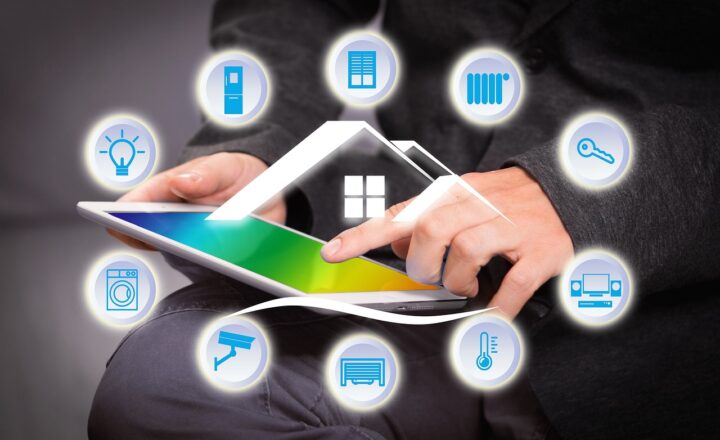
The Internet of Things (IoT) is revolutionizing how we interact with our homes, creating smarter living environments that can enhance convenience, security, and energy efficiency. With the proliferation of connected devices, the once-dreamt idea of a smart home is now a reality for many households around the world.
1. What is the Internet of Things (IoT)?
The Internet of Things (IoT) refers to the network of interconnected devices that communicate with each other through the internet. These devices include a wide variety of smart gadgets, ranging from home appliances to security cameras, which can collect and exchange data for greater functionality. The primary goal of IoT is to enable seamless interaction and automation in everyday tasks, making our lives easier and more efficient.
IoT devices are embedded with sensors, software, and other technologies that allow them to connect to and exchange data over the internet. This has sparked a massive wave of innovation across various industries, particularly in smart home technology.
2. The Rise of Smart Homes
Smart homes utilize IoT technology to create environments where household functions can be monitored and controlled remotely. This evolution began with simple devices, such as smart bulbs and thermostats, but has expanded into a multitude of smart appliances and systems that manage everything from lighting to security.
The key trends that have driven the rise of smart homes include:
- Increased Connectivity: The ubiquity of Wi-Fi and mobile data has paved the way for an expanding range of connected devices, elevating household automation to new heights.
- Consumer Demand for Convenience: As people grow busier, the desire for devices that enhance convenience and save time has surged, fueling demand for smart home solutions.
- Energy Efficiency & Sustainability: With environmental concerns on the rise, many consumers are turning to smart devices that help reduce energy consumption and lower utility bills.
- Advancements in Technology: The development of more affordable smart devices, alongside improvements in AI and machine learning, has accelerated the adoption of smart home technology.
3. Key Components of a Smart Home
Smart homes typically integrate several key components that communicate with each other, providing enhanced functionality and convenience. These components include:
- Smart Hubs: A central control system that connects and manages all smart devices within the home. Examples include Amazon Echo, Google Nest Hub, and Samsung SmartThings.
- Smart Lighting: LED bulbs that can be controlled via smartphone apps or voice commands, allowing users to adjust brightness, color, and schedules remotely.
- Smart Thermostats: Devices such as the Nest Learning Thermostat that learn user preferences and adjust heating/cooling systems for energy savings.
- Smart Security Systems: IoT-enabled cameras, motion sensors, and doorbell cameras that provide real-time monitoring and alerts for enhanced home security. Examples include Ring and Arlo.
- Smart Appliances: Refrigerators, washing machines, and ovens that connect to the internet and provide additional features like remote control, alerts, and monitoring.
- Smart Home Assistants: Voice-activated assistants like Amazon Alexa or Google Assistant that can control devices, set reminders, and provide information through voice commands.
By integrating these components, smart homes create an ecosystem that allows for greater automation and convenience, empowering homeowners to manage their living spaces more effectively.
4. Benefits of Smart Homes
The IoT has brought many benefits to the concept of smart homes, improving overall quality of life for residents. Some of the key advantages include:
- Enhanced Convenience: With the ability to control various devices remotely, homeowners can schedule automated tasks, like turning lights on/off or adjusting thermostats, offering unmatched convenience.
- Improved Security: Smart security systems provide real-time notifications and monitoring, allowing residents to secure their homes easily, even when away.
- Energy Efficiency: IoT devices can optimize energy consumption by learning user habits and adjusting settings automatically, leading to lower utility bills and a reduced carbon footprint.
- Remote Monitoring: Homeowners can monitor their dwelling remotely via smartphones, providing peace of mind and enabling quick responses in emergencies.
- Customization and Personalization: Smart home systems can be customized to meet individual needs, allowing homeowners to create their ideal living environment.
With such remarkable benefits, it’s no wonder that smart homes are becoming the norm rather than the exception.
5. Challenges and Considerations
Despite the numerous benefits, the transition to a smart home also comes with challenges. Homeowners should consider the following:
- Privacy and Security Risks: With gadgets collecting personal data and communicating over the internet, there are potential cybersecurity threats that must be addressed and mitigated.
- Compatibility Issues: Not all smart devices work seamlessly together. Homeowners need to ensure compatibility when selecting devices for their smart home ecosystem.
- Initial Cost and Maintenance: The cost of purchasing smart devices can be high, and ongoing maintenance, updates, and potential repairs should be budgeted for.
- Complexity of Use: For some users, especially those not technologically inclined, the complexity of setup and navigation can present a barrier to fully benefiting from smart technology.
As technology continues to advance, developers are working to address these challenges, enhancing the overall smart home experience.
6. The Future of Smart Homes
As IoT technology continues to evolve, the future of smart homes looks promising. We can expect to see:
- Integration of Advanced AI: More smart devices will incorporate artificial intelligence, allowing them to not only respond to commands but also to anticipate user needs based on behavior and preferences.
- Greater Interoperability: Future smart home systems are likely to prioritize seamless communication across devices from various manufacturers, offering a more unified experience.
- Sustainability Initiatives: Smart devices will increasingly focus on eco-friendly features, optimizing resource use and promoting sustainable living practices.
- Expanded Market Reach: As technology becomes more affordable, smart home solutions will penetrate diverse consumer markets, allowing a broader audience to experience the benefits of IoT.
The trajectory settings of smart homes point towards creating more intuitive and efficient living spaces that cater to the needs and aspirations of modern society.
Conclusion
The Internet of Things is undeniably shaping the future of home living, and the inception of smart homes marks a significant leap in how we manage our living environments. With countless benefits, greater efficiency, and continued advancements, smart homes are set to become a cornerstone of modern living. As we embrace this technology, the potential to create more secure, convenient, and energy-efficient homes grows exponentially. Now is the time to explore the diverse array of smart devices available and consider how they can transform your everyday life.








